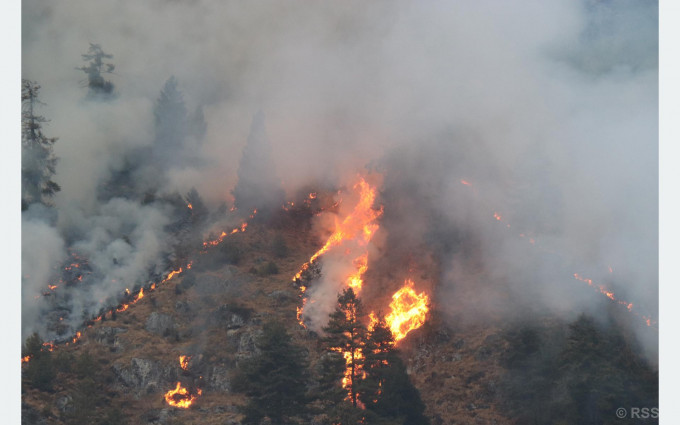First the Eritrean soldiers stole the pregnant woman’s food as she hid in the bush. Then they turned her away from a checkpoint when she was on the verge of labor.
So she had the baby at home and walked 12 days to get the famished child to a clinic in the northern Ethiopian region of Tigray. At 20 days old, baby Tigsti still had shriveled legs and a lifeless gaze — signs of what the United Nations’ top humanitarian official calls the world’s worst famine conditions in a decade.
“She survived because I held her close to my womb and kept hiding during the exhausting journey,” said Abeba Gebru, 37, from Getskimilesley.
Here, in war-torn Tigray, more than 350,000 people already face famine, according to the UN and other humanitarian groups. It is not just that people are starving; it is that many are being starved, The Associated Press found. In farming areas in Tigray to which the AP got rare access, farmers, aid workers and local officials confirmed that food had been turned into a weapon of war.
Ethiopian and Eritrean soldiers are blocking food aid and even stealing it, they said, and convoys with food and medical aid turned back by Ethiopian military officials as fighting resumed in the town of Hawzen. The soldiers also are accused of stopping farmers from harvesting or plowing, stealing the seeds for planting, killing livestock and looting farm equipment.
More than 2 million of Tigray’s 6 million people have already fled, unable to harvest their crops. And those who stayed often cannot plant new crops or till the land because they fear for their lives.
The grinding war in Tigray started in early November, shortly before the harvest season, as an attempt by Ethiopian Prime Minister Abiy Ahmed to disarm the region’s rebellious leaders.
On one side are guerrillas loyal to the ousted and now-fugitive leaders of Tigray. On the other are Ethiopian government troops, allied troops from neighboring Eritrea and militias from Ethiopia’s Amhara ethnic group who see themselves as rivals to the Tigrayan guerillas. Trapped in the middle are the civilians.
The war has spawned massacres, gang rapes and the widespread expulsion of civilians from their homes, and the United States has declared “ethnic cleansing” in western Tigray.
Tigray’s deputy CEO, Abebe Gebrehiwot, echoed the assessment of “ethnic cleansing,” citing “some players who don’t want us to... plow the land” and others who are preventing the distribution of seeds.
Ethiopia’s government strongly disputes that starvation is being used as a weapon of war. Mitiku Kassa, an official with the National Disaster Risk Management Commission, said Wednesday that the U.N. and others have “unfettered access” to Tigray.
“We don’t have any food shortage,” he declared.
That’s not what this seen out on the ground.
Teklemariam Gebremichael said he and his neighbors were no longer allowed to farm. When Eritrean soldiers came upon him looking after his cattle and harvesting crops, they shot both him and his cows, he said.
He survived. The cows didn’t. With food in short supply, his wound is slow to heal.
“I call on the world has to take immediate action to help Tigray, because we can’t live on our own land anymore,” he pleaded.
Hunger is a sensitive topic in Ethiopia, after images of starvation there in the 1980s led to a global outcry. Conflict contributed to that famine, which killed an estimated 1 million people.
Farming has not stopped entirely in Tigray, but it has become a dangerous act of resistance. On the road to Abi Adi, a town about 100 kilometers west of Mekele, the AP saw a few farmers out plowing or taking their cattle to pasture in the distant hills.
“If they (Eritrean soldiers) see us plowing, they beat us,” said 20-year-old farmer from Melbe, southwest of Mekele, who gave only his first name of Kibrom. “We only plow when we are sure they are not around.”
Besides preventing plowing, the soldiers took other measures to destroy food, witnesses said. One official with an aid group based in Mekele said Eritrean soldiers were known to contaminate food silos, sometimes mixing grain with sand and soil. And sometimes the looting by both Ethiopian and Eritrean soldiers included farm equipment, farmers said.
“All our farm tools, including plows, were looted and taken away on trucks,” said Birhanu Tsegay, 24-year-old farmer from Neksege town. “They left nothing there.”
At times food aid makes it through despite all the challenges, but there is never enough. Early in May a large crowd gathered under a scorching sun in Agula to share food bought with U.S. money.
“Demand for food in the villages is very high,” said Tekeste Gebrekidan, coordinator of the Relief Society of Tigray in the Tsirae Womberta district. The level of need, he said, is “beyond our capacity.”
The food they gave out that afternoon in Agula — 15 kilograms of wheat, half a kilogram of peas and some cooking oil per person, to last a month — was earmarked only for the most vulnerable. That included 60-year-old Letebrhan Belay.
“There will be people dying of hunger,” she said.
Some of the lucky ones, like nursing mother Abeba, make it past the many roadblocks to seek medical help in Abi Adi and Mekele, but they are few.
Four women and their babies were admitted in Abi Adi’s makeshift ward for malnourished babies when the AP was there.
Birhan Etsana, a 27-year-old mother from Dengelat, was still hanging onto the lone survivor of her triplets, a baby admitted at Mekele’s Ayder Hospital with complications stemming from severe acute malnutrition. The baby, Mebrhit, was 17 months old but weighed just 5.2 kilograms (11lbs 7oz) after a week in intensive care.
“Even when we were in the field and I gave her the breast, she couldn’t drink anything,” Birhan said. “It’s because of lack of food.”










